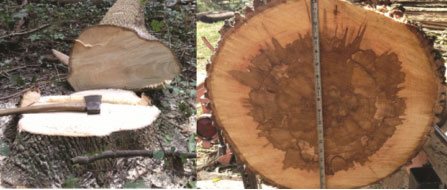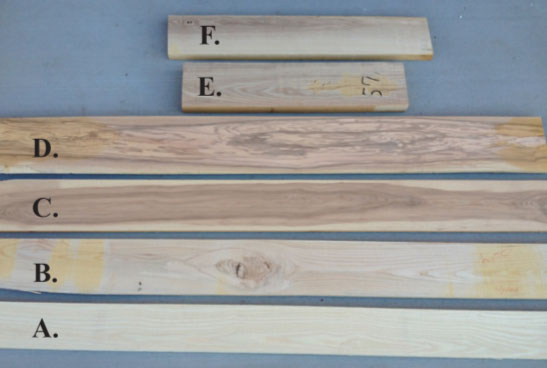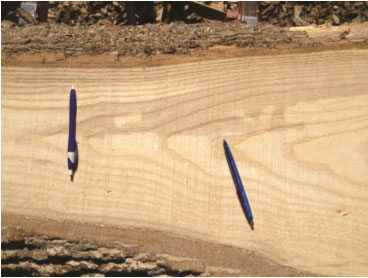Effect of EAB on Ash Wood Quality, Qualitative Observations
By Daniel Cassens
The Department of Forestry and Natural Resources at Purdue University has received conflicting reports about the suitability of Emerald Ash Borer (EAB) killed Ash trees for both lumber and mulch. As a result, about 15 saw log sized trees of various ages and vigor and infected with EAB were processed one at a time on a portable band mill. This process allowed all logs in each tree to be carefully examined for any quality issues.
Background
Considering growth rate and wood color, ash is an extremely variable wood and this variation could be creating some of the confusion in regards to its utilization. Ash, like oak, locust, elm, hackberry and a few minor species, is a ring porous wood. Each year the tree initiates a new growth ring and the very first cells (pores) formed are large in diameter and thin walled. Later in the growing season small diameter thick walled strong cells are formed. The transition between the thin walled cells (early wood) and the small thick walled cells (latewood) is abrupt. The latewood cells provide the density and strength that most ash is known for. If the tree lacks vigor and is slow growing, the latewood band of cells will be very narrow. The density and strength of all slow growth ring porous species goes down, and in extreme cases, the wood can be brash.
Wood color in ash can also create confusion. Color in any of the hardwoods and especially the light colored ones are difficult to quantify. Ash, like hard maple, basswood and other white wood species, does not form true heartwood. The brown and sometimes mottled or variegated “heartwood” is formed in response to wounding or branch stubs failing to heal promptly. Fast growth vigorous trees will be predominately white lustrous sapwood. Old trees and trees lacking vigor will have much larger heartwood (Figure 1). Figure 1. White ash log (left) with a very small heartwood and wide bands of sapwood. Ash log (right) with large variegated heartwood. It is important to examine the top end of butt logs as the heartwood seems to develop just a short distance up the stem.
Figure 1. White ash log (left) with a very small heartwood and wide bands of sapwood. Ash log (right) with large variegated heartwood. It is important to examine the top end of butt logs as the heartwood seems to develop just a short distance up the stem.
To further complicate the situation, the color of the white sapwood in healthy live ash can be affected by processing techniques. Allowing fresh ash logs or dead piled lumber to lie during warm weather will quickly result in oxidation stain. Oxidation stain is a chemical reaction in the wood which initially results in a somewhat darker, off white or graying of the wood. Oxidation stain is followed by fungal staining most commonly known as blue stain and then by actual decay.
Wood manufacturers who mass produce products, and especially those with a light natural finish generally prefer the white sapwood of ash. Mixing of the white sapwood with the brown and often variegated heartwood creates contrast and can lead to questions from the consumer. On the other hand, the variegated heartwood provides a decorative appearance and might be preferred by some custom wood manufacturers (Figure 2). From a strength standpoint, there is nothing wrong with either the sapwood or heartwood, unless the wood is very slow grown. Figure 2. Color variation as seen in several pieces of ash lumber. A. Lustrous white sapwood color in well cared for and well manufactured Ash board. B. Slightly off colored board and some staining due to EAB. C. Uniformly brown heartwood in ash. D. Heavily variegated heartwood color in Ash. E. Shows a commercially produced sapwood board with oxidation stain. F. Shows a second commercially produced board with some oxidation stain near the bottom and brown heartwood near the top.
Figure 2. Color variation as seen in several pieces of ash lumber. A. Lustrous white sapwood color in well cared for and well manufactured Ash board. B. Slightly off colored board and some staining due to EAB. C. Uniformly brown heartwood in ash. D. Heavily variegated heartwood color in Ash. E. Shows a commercially produced sapwood board with oxidation stain. F. Shows a second commercially produced board with some oxidation stain near the bottom and brown heartwood near the top.
Although the white sapwood is generally preferred in ash, the National Hardwood Lumber Association Rules for the Measurement and Inspection of Hardwood and Cypress lumber make no provisions for separation based on wood color. Neither of the two wholesale lumber pricing reports mentions color. So, the issue is left for the buyer and seller to determine what is acceptable. Heartwood or slightly off color wood is more acceptable in those products with a dark finish. For hard maple and birch the rules are very specific in regards to separation of the white sapwood and brown heartwood when specified.
Results
Vigorous 50 to 60 year-old ash trees with about 50 percent or more of their foliage dead were processed into lumber. These trees had very small heartwood and surprisingly, the sapwood looked white. During sawing, the logs had a fermenting smell and the wood looked only slightly off-white. After some drying (Figure 3) occasional light blue stain could be seen near the bark followed by a light brown discoloration further into the log. Normal white wood was also present. The discoloration in the EAB trees is lightly mottled almost like the heartwood formed in non-EAB trees but not near as dark. Figure 3. Shows stain developing near the outside of an EAB tree (log) that had lost nearly all of its foliage (right). Blue stain is seen on the left and near the bark edge, oxidation stain is indicated by the pen on the right, followed by bright white sapwood below.
Figure 3. Shows stain developing near the outside of an EAB tree (log) that had lost nearly all of its foliage (right). Blue stain is seen on the left and near the bark edge, oxidation stain is indicated by the pen on the right, followed by bright white sapwood below.
The top of trees is attacked by EAB first and then the insect continues to move down the stem. Upper logs are probably more deteriorated then butt logs. The attack is not uniform around the tree so some parts of the wood are more affected than others. The scattered light blue stain probably is the result of initial EAB attack. The hole allowed the blue stain fungus to enter the tree.
Very slowly grown, non-vigorous trees in the later stages of defoliation were also processed. This wood was predominately brown, lighter weight and probably brash. This condition is due to the slow growth of the trees and not EAB.
EAB trees that had been dead for an entire summer were not available for examination, but based on previous experience with dead ash trees discoloration will occur rapidly followed by decay. Shortly after an EAB tree loses its foliage discoloration will be complete and the material will be acceptable only for industrial lumber where color is not important. Probably within a year, decay will commence and the structural integrity of the wood is compromised.
Action To Take
From the onset, foresters and industry have correctly recommended the removal of all merchantable ash which had the potential of being infected by EAB. Although infected trees still have merchantable wood the timber buyer may not be able to commence harvesting in time to maximize value and will likely not pay more than pallet log price. Ash is not a highly valued species and the landowner should weigh the value of what the ash is worth and the impact of its harvest on any forest management plans for the specific stand. It is important to market ash trees prior to infestation.
Where only a few trees are involved it might be better to salvage the trees with a portable band mill. The material could be used for flooring, paneling or other local uses.
Ash is subject to powder post beetle damage, even after kiln drying. Infestation is highly variable. Wood products with a finish applied are protected because the beetle cannot penetrate the surface cells or pores to deposit eggs. Beetles are controlled by fumigation or heating to somewhat over 132 degrees Fahrenheit.
Daniel Cassens is an Extension Specialist and Professor of Wood Products with the Department of Forestry and Natural Resources, Purdue University.
